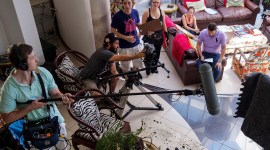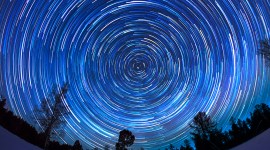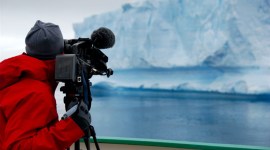
Recording Foley and Sound Effects: The Fundamentals
While using stock sound effects can yield great results and save crucial time, accurately and convincingly depicting the visuals may require foley work.
Above image from Soundcrafter
As every professional filmmaker and videographer knows, even the most gorgeous footage and brilliant camera work can lose power when unaccompanied by sound. For maximum emotional impact, foley sound, like ADR, must match the actions in the video that was filmed. Here are some tips and tricks for recording foley and sound effects.
 Image from Pyramind Studios
Image from Pyramind Studios
Soundstage & Acoustics
To capture a good recording, it is essential that your sound has sonic depth, width, and height. These spatial attributes are the difference between hi-fi and lo-fi recordings.
A typical room in an average sized home is going to be acoustically inferior to a larger room designed with acoustics in mind. Creating your own foley soundstage can aid you in squeezing that dimensional sound out of an average to smaller sized room. Additionally, the distortion of the depth, width, and height can be minimized by incorporating sound diffusion and sound absorption to nullify the room boundaries. The goal is to eliminate early reflections while maintaining a three-dimensional balance. That being said, constructing a soundstage is serious business. Let’s get to work!
Check out this effective and affordable DIY tutorial for quadratic diffusion from Austin Community College – Music Business, Performance and Technology. Thanks guys!
Foley Objects
Foley artists use many objects to achieve accurate depiction of the visual. Depending on the genre of the film, anything and everything is fair game. Before recording however, the first step entails reviewing the film and compiling a list of sound effects in the order they are seen. Next, the foley artist must determine what objects are appropriate for each specific sound effect. There are a few tried-and-true objects and techniques Hollywood foley artists have used for decades including:
- Thin sticks and dowel rods produce excellent whooshing SFX
- Old chairs and stools are perfect for controlled creaking
- Heavy-duty stapleguns serve for excellent gun noises
- Roll up a large phonebook for realistic body punches
- Twist and snap sticks of celery for convincing bone breaks
- Corn starch inside a leather pouch makes the sound of snow crunching
- Cut a coconut in half and line them with a soft material for a horse walking
- Ball up and walk over old audio tape for the sound of grass footsteps
- Locate an old car door or fender to produce metal and car crash sounds
- Flap a pair of cleaning gloves for the sound of realistic bird wings
Here’s an excellent video featuring Emmy nominated Foley Artist Caoimhe Doyle demonstrating some of these techniques.
Microphone Selection & Placement
Microphone selection is crucial to making foley audio “fit” with audio recorded on location. For interior scenes, a Neumann KM185, Oktava mk-012, Audix SCX1/HC or any hyper-cardiod condenser mic will capture good audio. Sensitive microphones are great at picking up subtle nuances in certain sound effects.
When matching foley for an outdoor scene, you may have better luck using a shotgun microphone similar to what is used on location shoots. There may even be some times where a large-diaphram condenser microphone is the way to go. By all means, use your ears to decide!
 Image from Dare to be Digital
Image from Dare to be Digital
Proximity and placement of the microphone in relation to the source of sound greatly affects how the foley is recorded. Close-up shots may require closer microphone placement, or put distance between the mic and sound source if you desire more room sound. Always remember to experiment with different microphone positions and choose the placement and preamp levels that best represent the visual in the film.
Recording & Execution
Foley artists have a very specific job in audio post-production that requires much creativity and improvising. Great detail is given to the breakdown and structure of the action that is being recorded. Check out the following video of foley artist Leslie Bloome to witness some of the ins and outs of the job.
Don’t have time to foley? We’ve got a broad selection of SFX at PremiumBeat. Give us a listen.
Have any other foley tips and tricks? Make some noise in the comments below.





